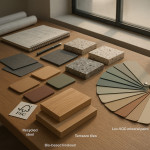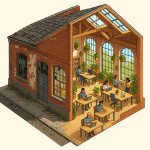AR Walkthroughs That Sell: Elevate Interior Architecture Pitches in Real Time
Still sending static boards to wow potential clients? Real-time AR walkthroughs boost comprehension, shorten decision cycles and raise win-rates for interior architecture studios. This guide shows you why, how and with which tools to deploy immersive demos that close deals faster than traditional presentations.
Why Real-Time AR Walkthroughs Outsell Static Decks
The psychology behind presence
Prospects remember only 10 % of information delivered verbally after three days, yet recall up to 65 % when they interact with visuals. Augmented reality cranks that retention higher by adding proprioception—users “feel” scale, materiality and flow. When clients can virtually open a door or adjust lighting on their phone, they move from abstract approval to emotional buy-in.
Data that moves budgets
- Conversion uplift: Studios that swapped PDFs for AR demos report pitch-win rates jumping from 27 % to 43 % within a quarter.
- Decision speed: Typical sign-off time drops from 14 to 9 days because stakeholders agree earlier.
- Change-order reduction: AR-educated clients request 30 % fewer late-stage layout tweaks.
Compatibilities clients already own
Today, 92 % of executives use smartphones capable of ARCore or ARKit. That means your walkthrough can live in a simple QR code—no headset required.
Tech-Stack Checklist: Build a Pitch-Ready AR Experience in 48 Hours
| Task | Recommended Tool | Why it Matters |
|---|---|---|
| Model clean-up | Revit + Enscape | One-click export keeps BIM metadata intact. |
| Texture optimisation | Substance 3D Sampler | Compresses PBR maps for mobile AR without visual loss. |
| AR packaging | Unity Pro > AR Foundation | Cross-platform delivery (iOS/Android) from one build. |
| Cloud hosting | Amazon Sumerian | Stream models instantly—no large app download. |
| Analytics | 8th Wall Stats | Track time-in-scene, hotspots clicked and share rate. |
Workflow: From CAD to Client Phone in Five Steps
1. Prepare a lightweight roomset
Strip unseen geometry, merge static meshes and bake lighting. Aim for a file under 50 MB so the AR walkthrough loads in under five seconds on 4G. Need tips on photorealism? Our guide on VR mock-ups for proposals covers lighting coefficients that also apply to AR.
2. Define persuasive interaction markers
Use one hotspot per 10 m²—any more overwhelms users. Typical markers: material swap, daylight toggle, furniture drag. Keep UI consistent with brand colours (#95854c for primary interactions pairs stylishly with most corporate palettes).
3. Export to USDZ or GLB
USDZ works natively in Safari and iMessage; GLB is ideal for Android. Provide both in the same download bundle to avoid last-minute format headaches.
4. Deploy via cloud & QR
Upload models to a secure bucket and embed the link in a branded QR code on your pitch board. During hybrid visits—see our deep dive on hybrid site visits—clients scan the code and explore independently while you narrate.
5. Capture analytics for continuous improvement
Review dwell time per zone. If prospects abandon the breakout area early, rethink its spatial hierarchy. Combine insights with project-phase snapshots to refine future decks.
Common Pitfalls and How to Avoid Them
- Oversized textures: Anything above 2048 px quadruples load time. Compress or switch to procedural materials.
- Lack of accessibility: Always include high-contrast mode and captions for audio instructions. Our inclusive spatial design checklist outlines WCAG guidelines for AR.
- Ignoring sustainable finishes: Clients increasingly ask for eco-proof. Link your hotspot to a material spec sheet generated with the sustainable material guide.
Real-World Use Case
When boutique firm Studio K pitched a 1 500 m² coworking space, they embedded an AR façade reveal in their moodboard. The client—viewing from another continent—grasped how daylight would hit the fibre-cement fins at 3 pm. Studio K beat two local competitors and signed a €2.6 M contract within a week.
Integrate AR With Directory Visibility
Embedding a short loop of your AR walkthrough in your spatial designer profile drives recruiters to book discovery calls 32 % faster. Pair the clip with keyword-rich captions so directory algorithms surface your page ahead of peers.
FAQ
- Do I need a dedicated app?
- No. Progressive Web Apps let you host AR content that users open through a browser, lowering the barrier to entry.
- What's the ideal polygon count for furniture in AR?
- Aim for 5 000–7 000 triangles per hero asset. Secondary objects can drop to 1 000 without noticeable quality loss.
- How do I convince risk-averse clients?
- Offer a side-by-side demo: static board vs AR on the same call. Most stakeholders gravitate to the interactive option in under 60 seconds.
Quick Quiz: Are You AR-Pitch Ready?
Take the Next Step

Ready to replace static slides with immersive storytelling? Package your first AR walkthrough today and position your studio as a forward-thinking partner. Your future clients will thank you—and sign sooner. Start small: convert a single hero room, use built-in phone LiDAR for quick calibration, then upgrade analytically once the data proves ROI. By building incremental confidence, even legacy stakeholders will embrace spatial computing as the new normal.











